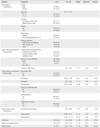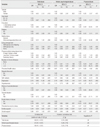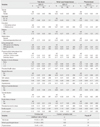Abstract
Purpose
This study was conducted to identify risk factors that influence the probability and severity of elder abuse in community-dwelling older adults.
Methods
This study was a cross-sectional descriptive study. Self-report questionnaires were used to collect data from community-dwelling Koreans, 65 and older (N=416). Logistic regression, negative binomial regression and zero-inflated negative binomial regression model for abuse count data were utilized to determine risk factors for elder abuse.
Results
The rate of older adults who experienced any one category of abuse was 32.5%. By zero-inflated negative binomial regression analysis, the experience of verbal-psychological abuse was associated with marital status and family support, while the experience of physical abuse was associated with self-esteem, perceived economic stress and family support. Family support was found to be a salient risk factor of probability of abuse in both verbal-psychological and physical abuse. Self-esteem was found to be a salient risk factor of probability and severity of abuse in physical abuse alone.
Figures and Tables
References
1. Azagba S, Sharaf MF. Psychosocial working conditions and the utilization of health care services. BMC Public Health. 2011. 11:642. http://dx.doi.org/10.1186/1471-2458-11-642.
2. Bae JY. Structural equational modeling for elderly suicidal thought. Soc Sci Rev. 2005. 23:343–375.
3. Baker MW, Heitkemper MM. The roles of nurses on interprofessional teams to combat elder mistreatment. Nurs Outlook. 2005. 53:253–259. http://dx.doi.org/10.1016/j.outlook.2005.04.001.
4. Cooper C, Selwood A, Livingston G. The prevalence of elder abuse and neglect: A systematic review. Age Ageing. 2008. 37:151–160. http://dx.doi.org/10.1093/ageing/afm194.
5. Daly JM. Evidence-based practice guideline: Elder abuse prevention. J Gerontol Nurs. 2011. 37(11):11–17. http://dx.doi. org/10.3928/00989134-20111004-01.
6. Dong XQ, Simon MA, Beck TT, Farran C, McCann J, de Leon CFM, et al. Elder abuse and mortality: The role of psychological and social wellbeing. Gerontology. 2011. 57:549–558. http://dx.doi.org/10.1159/000321881.
7. Jackson SL, Hafemeister TL. Risk factors associated with elder abuse: The importance of differentiating by type of elder maltreatment. Violence Vict. 2011. 26:738–757. http://dx.doi.org/10.1891/0886-6708.26.6.738.
8. Jang TY, Jang TS. Marginal effect of causal elements on traffic accidents. J Korean Reg Dev Assoc. 2004. 16:75–87.
9. Jon BJ. Self-esteem: A test of its measurability. Yonsei Nonchong. 1974. 1:107–130.
10. Kee BS. A preliminary study for the standardization of geriatric depression scale short form-Korea version. J Korean Neuropsychiatr Assoc. 1996. 35:298–307.
11. Khan A, Ullah S, Nitz J. Statistical modelling of falls count data with excess zeros. Inj Prev. 2011. 17:266–270. http://dx.doi.org/10.1136/ip.2011.031740.
12. Kim HJ. A study on the assessment of the risk factors of elderly abuse. J Welf Aged. 2007. 37:67–87.
13. Kim JY, Kim K. A study on predictors of the elder abuse: Focused on the elderly characteristics and family environments. Korean Criminol Rev. 2007. 18:1341–1360.
14. Kim S, Park IS. Elder abuse. J Korean Geriatr Psychiatry . 2010. 14:3–8.
15. Ko CM. A study of nurses' characteristics and their perception of seriousness of elder abuse. J Korean Acad Fundam Nurs. 2010. 17:109–118.
16. Korea Elder Protection Agency. The report of current state on elder-abuse. 2010. Retrieved April 4, 2012. from http://www.noinboho.or.kr/board2/bbs/board.php?bo_table=news&wr_id=5.
17. Luo Y, Waite LJ. Mistreatment and psychological well-being among older adults: Exploring the role of psychosocial resources and deficits. J Gerontol B Psychol Sci Soc Sci. 2011. 66:217–229. http://dx.doi.org/10.1093/geronb/gbq096.
18. Ministry of Health and Welfare. The report of national survey on elder abuse. 2010. Retrieved April 4, 2012. from http://www.mw.go.kr/front/al/sal0301vw.jsp?PAR_MENU_ID=04&MENU_ID=0403&BOARD_ID=140&BOARD_FLAG=00&CONT_SEQ=237769&page=1.
19. Morrison-Beedy D, Carey MP, Feng CY, Tu XM. Predicting sexual risk behaviors among adolescent and young women using a prospective diary method. Res Nurs Health. 2008. 31:329–340. http://dx.doi.org/10.1002/nur.20263.
20. Oh J, Kim HS, Martins D, Kim H. A study of elder abuse in Korea. Int J Nurs Stud. 2006. 43:203–214. http://dx.doi.org/10.1016/j.ijnurstu.2005.03.005.
21. Schiamberg LB, Gans D. An ecological framework for contextual risk factors in elder abuse by adult children. J Elder Abuse Negl. 1999. 11:79–103. http://dx.doi.org/10.1300/J084v11n01_05.
22. Schmeidel AN, Daly JM, Rosenbaum ME, Schmuch GA, Jogerst GJ. Health care professionals' perspectives on barriers to elder abuse detection and reporting in primary care settings. J Elder Abuse Negl. 2012. 24:17–36. http://dx.doi.org/10.1080/08946566.2011.608044.
23. Shin DS. A study on the correlation among family support, depression and physical health status in elderly. 1996. Seoul: Kyung Hee University;Unpublished master's thesis.
24. So H, Kim H, Jung M. A study about elder abuse experience of elderly people. Korean J Rehabil Nurs. 2009. 12:120–129.
25. Sohn E. A study on how the experience of old females affects their mental health. 2002. Seoul: Yonsei University;Unpublished master's thesis.
26. Song MS. Construct of a functional status prediction model for the elderly. 1991. Seoul: Seoul National University;Unpublished doctoral dissertation.
27. Song MS. Elderly abuse in domestic settings: Nursing perspective. Korean J Nurs Query. 2007. 16:78–101.
28. World Health Organization. A global response to elder abuse and neglect: Building primary heath care capacity to deal with the problem world wide: Main report. 2002. Retrieved April 7, 2012. from http://www.who.int/ageing/projects/elder_abuse/en/index.html.
29. Yang KM. A study of elder abuse in the domestic setting: Coping strategies and the consequences of elder abuse. J Korean Acad Nurs. 2004. 34:1047–1056.
30. Zaninotto P, Falaschetti E. Comparison of methods for modelling a count outcome with excess zeros: Application to activities of daily living (ADL-s). J Epidemiol Community Health. 2011. 65:205–210. http://dx.doi.org/10.1136/jech.2008.079640.




 PDF
PDF ePub
ePub Citation
Citation Print
Print






 XML Download
XML Download